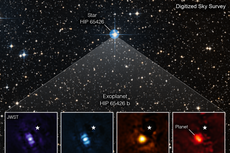Nasa’s James Webb telescope spots the oldest star clusters ever seen
Nasa’s James Webb Space Telescope has spotted the oldest star clusters ever seen.
The clumps of millions of stars might include the first and oldest stars in the universe, according to the researchers who find them.
The findings come from scientific analysis of Webb’s First Deep Field image. That image, which contains thousands of twinkling galaxies, became famous as one of the first pictures to be released from Nasa’s new telescope.

“JWST was built to find the first stars and the first galaxies and to help us understand the origins of complexity in the universe, such as the chemical elements and the building blocks of life,” says Lamiya Mowla, Dunlap Fellow at the Dunlap Institute for Astronomy & Astrophysics at the University of Toronto and co-lead author of the study.
“This discovery in Webb’s First Deep Field is already providing a detailed look at the earliest phase of star formation, confirming the incredible power of JWST.”
The findings are just the latest breakthrough from the James Webb Space Telescope, which scientists have suggested could change how we do astronomy fundamentally because of the sheer amount of data it is able to give us.
Just in recent days, it has tracked Nasa’s similarly groundbreaking DART mission from afar and given new insights into Neptune.
Now it has been used to begin a hunt that could end with the discovery of the oldest stars ever seen. And they were lurking, hidden in that early image that delighted the world.
From that image, researchers looked at the “Sparkler” galaxy. That galaxy is 9 billion light years away but can be seen in part because of the “sparkles” that surround it, appearing as orange dots.
Scientists thought that those sparkles could be recently-formed clusters that are creating stars, or older globular clusters, which are ancient collections of stars that formed in the very beginning of a galaxy. Scientists looked at 12 of those objects and found that five of them were globular clusters – and some of the oldest ever spotted.
The clusters are so old that they were born almost as soon as possible as it was actually form stars.
“Looking at the first images from JWST and discovering old globular clusters around distant galaxies was an incredible moment, one that wasn’t possible with previous Hubble Space Telescope imaging,” says Kartheik G. Iyer, Dunlap Fellow at the Dunlap Institute for Astronomy & Astrophysics at the University of Toronto and co-lead author of the study, in a statement.
“Since we could observe the sparkles across a range of wavelengths, we could model them and better understand their physical properties, like how old they are and how many stars they contain. We hope the knowledge that globular clusters can be observed at from such great distances with JWST will spur further science and searches for similar objects.”
Until now, those the objects around the Sparkler galaxy had been difficult to actually see. But the increased sensitivity of Nasa’s new telescope meant they could be looked at closely enough to understand what they are, and how old they might be.
The new findings are published in an article, ‘The Sparkler: Evolved high-redshift globular cluster candidates captured by JWST’, published in The Astrophysical Journal Letters.
Join our commenting forum
Join thought-provoking conversations, follow other Independent readers and see their replies
Comments


Bookmark popover
Removed from bookmarks